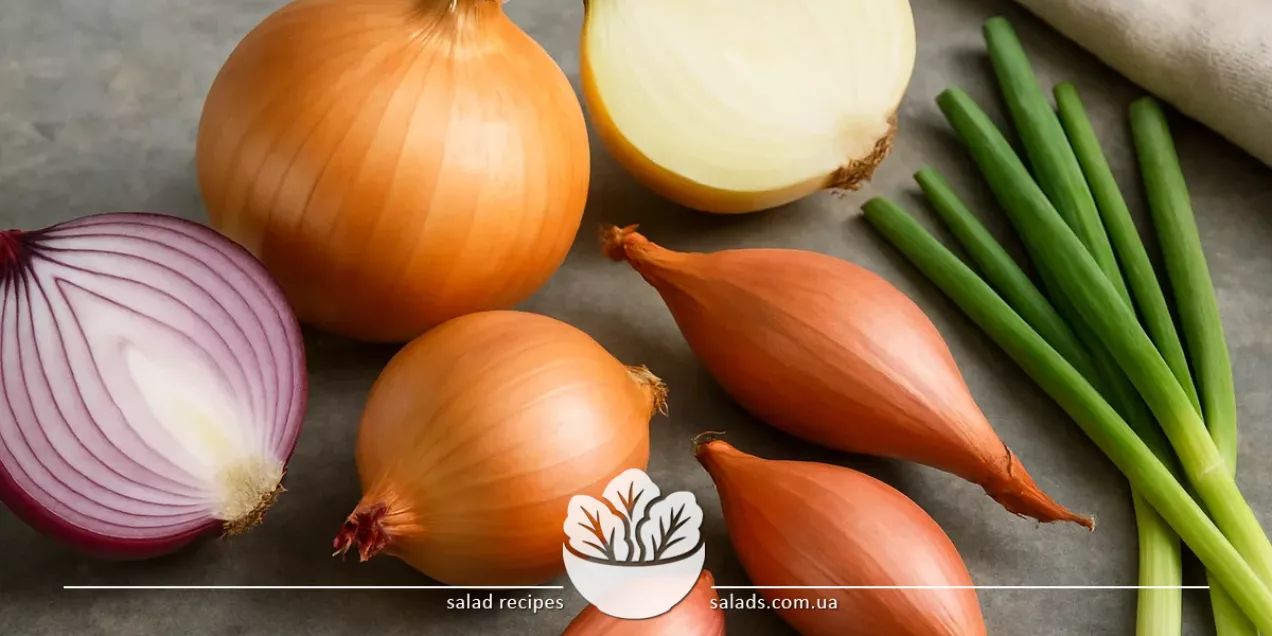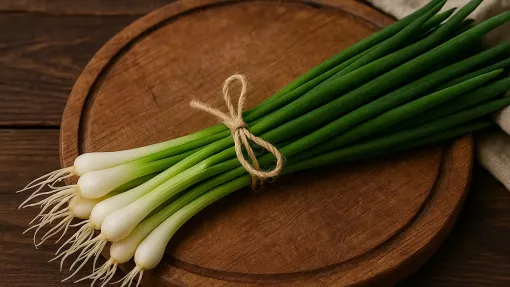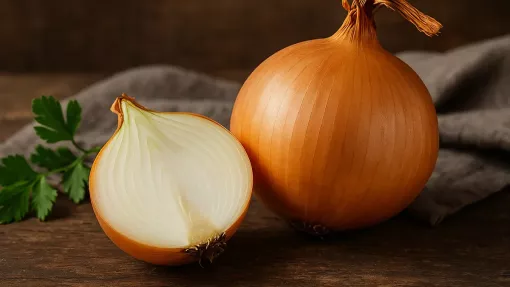Onion

Onion is an essential ingredient in most world cuisines, providing the aromatic foundation for hundreds of dishes. It can be sharp or sweet, mild or pungent – depending on the variety and method of preparation. Onion is used raw, fried, braised, caramelized, or roasted. It’s added to meat, fish, vegetables, sauces, soups, and salads. More about vegetables – in the vegetables category.
Different Types of Onion
Yellow, Red, White: The Basic Varieties
Yellow onion is the most common variety and serves as a universal base for numerous dishes. It has a sharp flavor when raw but becomes sweet and mellow after cooking. Yellow onion is typically sautéed at the start of making soups, stews, and meat dishes. It caramelizes well and creates a rich aromatic base that’s hard to replace with other ingredients. Red onion has a milder flavor, vivid color, and subtle sweetness. It’s often used raw in salads, appetizers, salsas, and sauces. Due to its lower pungency, it works well in dressings, marinades, and recipes that require a soft onion note without overpowering other flavors. Red onion can be pickled – turning a vibrant pink and becoming an ideal addition to burgers, sandwiches, and cold appetizers.
White onion has a delicate flavor and high juice content. It cooks faster and has a milder aroma. This variety is often used in Mexican and Mediterranean cuisines, pairing well with tomatoes, avocado, peppers, and legumes. It’s added to salsas, soups, and braised vegetables. Onion is most commonly paired with cabbage, especially in braised dishes, pies, and casseroles. Together, they create a soft texture and rich flavor suitable for both traditional and modern recipes.
Green Onion, Shallot, Leek: Mild and Delicate Options
Green onion refers to young shoots with tender stalks and a light onion aroma. It’s perfect for salads, cold appetizers, soups, omelets, and side dishes. Often added at the end of cooking to retain its fresh taste and aroma, green onion pairs well with dairy products, eggs, cheeses, and herbs, and is frequently used to garnish dishes before serving. Shallot has smaller bulbs and a more refined, subtle aroma. Its flavor is milder and sweeter than yellow onion, making it an excellent choice for sauces, dressings, delicate salads, or seafood dishes. Shallots caramelize well, are great for cooking in butter, and are commonly used in European cuisine.
Leek is another delicate onion variety with a soft, sweet flavor. Its thick white and green stalks are sliced and added to cream soups, vegetable stews, and pies. Leek is less pungent, making it ideal for children or those who avoid strong flavors. It can be fried, braised, roasted, or added to broths. These onion types pair well with sweet peppers in salads, casseroles, or vegetable starters. This combination delivers a balanced aroma and diverse texture.
Onion in Main Dishes, Sauces, and Casseroles
Onion is the base of many hot dishes. In meat and vegetable stews, it builds flavor depth, serving not just as an ingredient but as the foundation of the entire dish. It's sautéed until translucent or golden to caramelize its natural sugars and enhance aroma. In soups, borscht, and sauces, it’s usually the first item in the pan. Onion is often combined with carrots, garlic, tomatoes, or spices to form a classic flavor base. It’s used in pilafs, meatballs, goulash, sautéed vegetables, and stuffing. In stuffed vegetable dishes, onion is added to the filling, sauce, or vegetable mix. It enhances texture, adds aroma, and balances other flavors.
In casseroles, onion plays various roles: as a flavor base, a separate layer, or part of the filling. It’s most often combined with cheese, potatoes, meat, or vegetables. Pre-sautéed onion gives baked dishes a distinct aroma, especially in recipes with eggs, cream, or soft cheeses. A classic pairing is onion with tomatoes – together they form the base for sautés, sauces, casseroles, and gravies. This combination is popular in both national cuisines and everyday home meals.
Onion in National Cuisines: Universal Versatility
Onion is part of traditional dishes in nearly every national cuisine. In French cuisine, onion soup holds a special place, where the key ingredient is slowly caramelized yellow onion with broth, wine, and melted cheese. Shallot is widely used in sauces like bordelaise or vinaigrette. In Greek cuisine, onion is added to moussaka; in Italian – to pasta sauces, risotto, and vegetable bakes. In Caucasian cuisine, it’s added to meat, vegetables, and legumes. It’s often sliced into rings, lightly pickled, and served with kebabs or oven dishes. In Eastern European cuisine, it’s a base for borscht, stuffed cabbage rolls, meat patties, pâtés, and braised cabbage. Fried onion is often used as filling for pies, dumplings, and crepes.
In Mexican cuisine, white onion is a staple for salsa, tacos, and soups. It pairs well with hot peppers, tomatoes, corn, and legumes. In Asian cuisine, it’s added to noodles, wok dishes, and soups. Leek is popular in China, and green onion in Japan, Korea, and Vietnam. Onion is almost always paired with garlic – the two form a classic aromatic base. They’re used together in hundreds of recipes – from soups to stews, from salads to sauces.
How to Choose, Store, and Prepare Onion
Onion should be stored in a dry, well-ventilated place at room temperature, away from direct sunlight. Yellow, white, and red onions store best – in mesh bags, crates, perforated sacks, or tied bundles. Avoid storing them in the fridge – humidity promotes sprouting and spoilage. Green onion should be stored in the refrigerator, wrapped in a damp paper towel and placed in a bag. When choosing, look for firm bulbs, dry outer skins, and no soft spots or blemishes. Bulbs should feel heavy for their size. Green onions should have fresh, non-wilted stalks, free of slime or discoloration.
Before use, onion is peeled and chopped as the recipe requires: into rings, half-rings, cubes, or slices. The finer it is chopped, the more intense its flavor becomes. To achieve a mild aroma, add it at the end of cooking; for a strong flavor – at the beginning, sautéing until golden. Cooked onion pairs well with eggplants, forming a soft, rich base for bakes, sautés, or stews.

